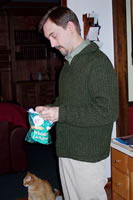Manly Cardigan: Seamless Knit Raglan Cardigan Pattern
NOTE: In progress. There's something wrong right now. But fiddle and see the coolness of it all anyway. :)
Get updates about my new patterns at my blog (The Knitting Fiend.)
The pattern generator on this page will create a pattern to knit a basic raglan cardigan. I added a decorative cable at the shoulders and pockets to Jim's sweater. The pattern created by the program doesn't describe how to knit those, but I'll give you links. (Jim's wearing the sweater right now, but I haven't gotten him to stand still for the photo opportunity yet!)
A pattern generator is a program that creates a pattern. If you want to customize for your size, your yarn or anything else, click the go-away box on the pattern window that popped up. Then, scroll down, and make changes. Then click any the pop-up window button you find on this page. opening. That will create your customized pattern.
Here is a list of features available with this generator:
- You can run it for free, but a donation is requested if you
knit the sweater.
- As usual, enter the gauge for your yarn.
- Shape: Raglan cardigan knit bottom to top.
- Directions will describe how to knit a simple raglan slant
decrease. Other decreases are described at the blog: Four Stitch Wide
Raglan Slant, and Decorative Cable
Inserted In Raglan Decrease.
- Crew
neck.
- Yarn Estimator: Stockinette, Broken Rib Stitch. Other stitches may take more or less yarn.
 Men's 38 displayed; you can change this to Women's
4-22; Men's 32-50. 18" doll and children's sizes. Custom
setting lets you
modify the size to better suit you. Jim's sweater is a men's size 38,
but I then picked "custom", and shortened the sleeves and body.
Men's 38 displayed; you can change this to Women's
4-22; Men's 32-50. 18" doll and children's sizes. Custom
setting lets you
modify the size to better suit you. Jim's sweater is a men's size 38,
but I then picked "custom", and shortened the sleeves and body.- Click this pop up pattern button to get your pattern. (I advise clicking it now. Really.)
- If the window doesn't pop up, scroll to the bottom and read
the final instructions about pop-up windows.
- 8 skeins of Araucania "Nature Wool Chunky". I bought
mine at Zora's Yarn!
in Naperville, Illinois. The Nature Wool has 131 yards (120 m)
per 100
grams; presumably this is chunky. The manufacturer's label
recommend a gauge of 3.5
st/ inch; I liked it knit a bit tighter and used a gauge of 3.8 st/inch.
- Denise
circular needles with size 8 tips attached for main
stitch and size 6 for trim. Using the Denise needles let me
change the length of the
cable. It needs to be very long when you put all the stitches on
the yoke; smaller is better when you knit the top of the sleeves.
- Crystal Palace double pointed needles for the cuffs and bottom of the sleeves.
- Two very small diameter double pointed needles to help pick
up stitches.
- Tapestry needle to sew the underarms.
- A crochet hook to fix occasional mistakes.
- 5 - 7 buttons in a size you like. I used five 7/8"
for
Jim's sweater.
- Raglan 'seams'. Nifty Cables I wedged between the decreases. (Pattern instructions will create 2 stitch wide seams.)
- Picking up stitches for button bands.
- Spacing
buttonholes. I used five buttonholes; next time I knit a
cardigan for Jim I plan to use six.
- Working buttonholes. I knit 2 stitch wide buttonholes.
- Insert
pockets. Detailed tutorial on adding pockets; I added 4" deep
pockets to Jim's sweater. You'll need to make a note on your
pattern, and remember to add the opening when the sweater measures 4"
above the ribbing.